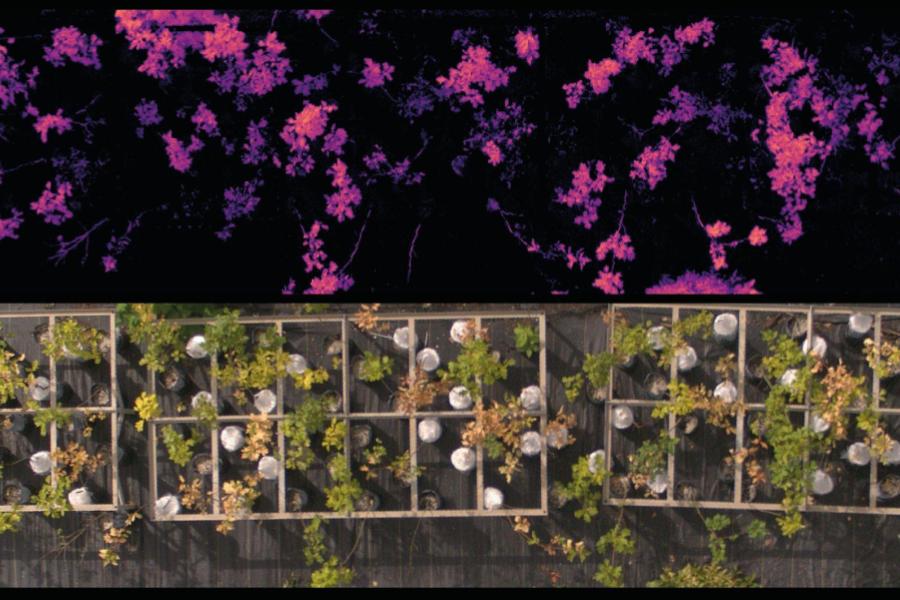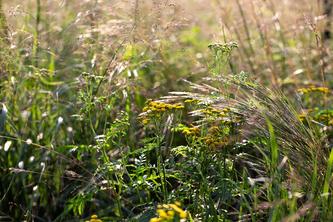
Oak forests play a vital role in our ecosystem, providing climate regulation and erosion control across North America. However, these forests face compounding threats from drought and oak wilt, and it can be challenging to tell these two issues apart.
Using an innovative approach that combines remote sensing tools with physiological measurements, University of Minnesota researchers developed a way to detect oak wilt early and accurately — an important step in safeguarding the health of oak-dominated forests.
Newly published research in the Proceedings of the National Academy of Sciences demonstrates the ability to predict physiological processes related to oak wilt and drought stress from light reflected from canopies.
“Forest health specialists often comment on how difficult it is to distinguish between oaks dying from two-lined chestnut borer and drought impact versus oak wilt in the same forest stands. This research demonstrates the potential to detect and differentiate between these two critical oak problems,” said Jennifer Juzwik, an adjunct associate professor in the University’s College of Food, Agricultural and Natural Resource Sciences.
Using spectral ecophysiology, a novel integration of plant ecophysiology and remote sensing for advanced plant stress monitoring, this approach enables early detection of oak wilt and drought. It combines biological insights with landscape measurement efficiency.
The researchers found:
- By analyzing spectral reflectance data, specific indicators like declines in photosynthetic efficiency and loss of leaf rehydration capacity could be detected up to two weeks before trees show visual signs of decline.
- The patterns of decline in the canopies mirror the patterns of blocked conduits in the stems, and these patterns are specific of each type of stress.
- Further research based on this method could allow early detection of a variety of threats to forest health.
“These models are like superhuman eyes — they see light at wavelengths far beyond what we can see. Once trained, they can use the information hidden to our eyes to translate light into physiology,” said lead author Gerard Sapes, a biological scientist at the University of Florida, formerly a postdoctoral researcher at the University of Minnesota.
This breakthrough encourages further exploration of the intricate links between ecophysiology and spectral reflectance, paving the way for more nuanced plant stress assessment. This research is a significant stride toward efficient, widespread application of plant stress monitoring.
“The study provides an elegant integration of physiological methods and spectral biology to detect and differentiate drought effects and disease effects in young trees. We are now able to accurately predict disease development and drought in oaks,” said Jeannine Cavender-Bares, director of the ASCEND Biology Integration Institute and a professor in the College of Biological Sciences.
Future research should explore broader applications of spectral ecophysiology to better understand what can and cannot be predicted from spectral reflectance. Scaling up the methodology to cover larger forested areas and diverse ecosystems would enhance its ability to generalize, but doing so will bring new challenges that will require research-based solutions.
Collaborative efforts with forest management agencies and policymakers are crucial for the integration and scaling of these innovative methods into real-world monitoring and management practices.
This work was supported by the NSF ASCEND Biology Integration Institute, NASA Biodiversity program, Minnesota Invasive Terrestrial Plants and Pests Center with support from the Minnesota Environment and Natural Resources Trust Fund as recommended by the Legislative-Citizen Commission on Minnesota Resources and the Cedar Creek Long Term Ecological Research program.
About the ASCEND Biology Integration Institute
The NSF Biology Integration Institute ASCEND (Advancing Spectral biology in Changing Environments) seeks to understand the causes and consequences of changes in plant diversity across scales in our era of rapid global change and to train the next generation of integrative biologists. Learn more at: https://www.spectralbiology.org
About the College of Biological Sciences
The College of Biological Sciences at the University of Minnesota is one of two colleges in the United States dedicated to the biological sciences with undergraduate majors and graduate programs that cover the spectrum of life from molecules to ecosystems. Learn more at cbs.umn.edu.
About the College of Food, Agricultural and Natural Resource Sciences
The University of Minnesota’s College of Food, Agricultural and Natural Resource Sciences (CFANS) strives to inspire minds, nourish people, and sustainably enhance the natural environment. CFANS has a legacy of innovation, bringing discoveries to life through science and educating the next generation of leaders. Every day, students, faculty, and researchers use science to address the grand challenges of the world today and in the future. CFANS offers an unparalleled expanse of experiential learning opportunities for students and the community, with 12 academic departments, 10 research and outreach centers across the state, the Minnesota Landscape Arboretum, the Bell Museum of Natural History, and dozens of interdisciplinary centers. Learn more at cfans.umn.edu.
About the Minnesota Invasive Terrestrial Plants and Pests Center
The Minnesota Invasive Terrestrial Plants and Pests Center (MITPPC) was founded by the Minnesota Legislature to research the prevention, detection and control of terrestrial invasive species. MITPPC researchers use transformative science to prevent and minimize the threats posed by land-based invasive plants, pathogens, and pests. Founded in 2015, MITPPC is the only research center of its kind in the country, and the center's work to protect the state's native prairies, forests, wetlands, and agricultural resources benefits all of Minnesota and beyond. Learn more at mitppc.umn.edu.
- Categories:
- Agriculture and Environment
- Forestry





